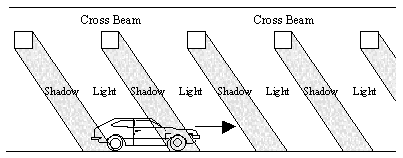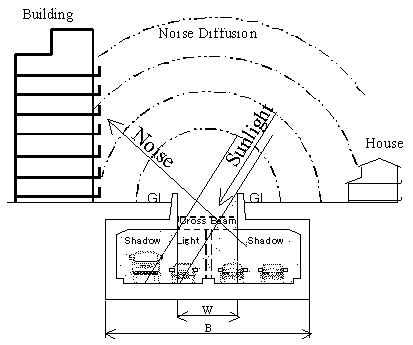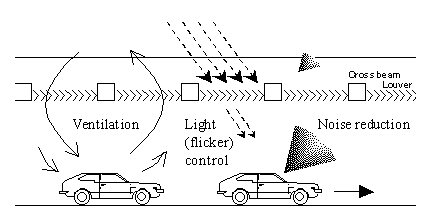A louver system for half-covered road structures and intermittent tunnels has been developed, in which three functions of light control (for visual environment in roadway space), noise reduction and ventilation control (both for environmental conservation of surrounding urban areas) are combined in one and the same system (in this paper referred to as multi-functional louver, or M.F. louver). This solution has been applied in real structures, and the surrounding population as well as the road users are satisfied with the results.
Introduction
In recent years, examples of half-covered road structures are increasing in urban areas. Also in Japan, half-covered road structures have been planned and constructed in Tokyo, Osaka and elsewhere. At the moment the planning and construction has commenced for a large scale half-covered (half-submerged) tunnel in Tokyo.
Half-covered road structures preserve the urban appearance, and compared to a tunnel structure, especially the cost of artificial ventilation can be largely reduced. These structures still have some outstanding issues, such as noise emission to the surrounding area and visual environment in the roadway space.
For these reasons, a louver construction has been developed in Japan, in which three functions of noise reduction, light control and ventilation are combined in one and the same structure, as further described in this paper.
Basic functions of louvers
Figure 1 shows louvers installed in front of tunnel entrances. In this case, the main function is normally in terms of entrance lighting as alternative for artificial lighting.
|
|
Figure 1
Schematic Concept for Louver at tunnel entrance |
In case louvers are installed at the open part of intermittent tunnels(Figure 2), the main function is often to improve the visual environment. Because the lighting level in this case is different from that of tunnel entrances, the shape of the louver blades will normally also be different.
 |
Figure 2
Louver at open part of intermittent tunnel |
In addition, louvers at open part of intermittent tunnels will cause part of the ventilated air from the upstream tunnel to flow into the downstream tunnel, and may therefore affect the ventilation requirements of the downstream tunnel.
It is important to carry out investigations for louvers in terms of tunnel planning.
Louvers can play an important role in figure 3, 4, 5:
- reducing the emission of noise to the surrounding area
- functioning of ventilation effect
- eliminating the flicker effect caused by cross beams and strong contrast caused by incoming sunlight
 |
Figure 3
Flicker effect due to cross beams |
 |
Figure 4
Visual environment and noise reduction |
 |
Figure 5
Possible functions of louvers |
Louvers must be designed in such a way that
- the required ventilation air volume is preserved
- the required reduction of traffic noise to the surrounding area is preserved
- the required luminance level in the roadway space is preserved
With these basic conditions, louvers have been developed and applied successfully to Japanese highways since the 1980fs.
|

